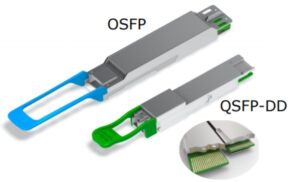EE World had a conversation with Anthony Yu from GlobalFoundries about the trends and tradeoffs in co-packaged optics and silicon photonics due to the increasing data demand driven by AI. The current focus is on balancing speed and reliability.
![]()
The rise in data consumption, especially with AI applications, is disrupting the traditional methods of increasing data speeds in data centers and networks. The pressure to enhance data rates quickly is evident, with forecasts predicting substantial growth in data center investments. This demand is pushing semiconductor manufacturers to innovate, with a focus on enhancing reliability while meeting speed requirements.

OSFP and QSFP-DD optical modules. (Image: Fiber Mall)
Data centers currently utilize pluggable optical modules to connect servers and network switches. However, as data speeds reach 224 Gb/sec per lane, maintaining signal integrity becomes a challenge due to long connection distances. To address these issues, there is a shift towards co-packaged optics, where the optical transceiver is integrated into the ASIC package, utilizing silicon photonics to reduce signal travel distances.
While co-packaged optics offer improved data rates, there are concerns about reliability, especially in the event of component failure. Innovations are underway to address these concerns and ensure field-replaceability without disrupting the ASIC.
EE World: Anthony Yu from GlobalFoundries. Thank you for sharing your insights on silicon photonics and co-packaged optics. The industry is facing challenges in meeting the increasing data demands efficiently and reliably.

Anthony Yu, GlobalFoundries
Yu: The landscape has evolved significantly since our last discussion, with a growing focus on silicon photonics for optical interconnects to support advanced AI applications and data-intensive processes.



